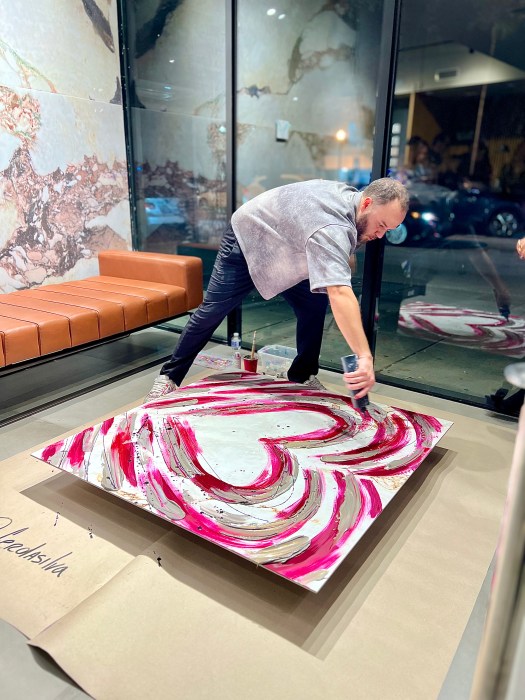By Lucas Mann
You can call him Clark Clarken or Clark Clark or, most simply, just Clark. Whichever way, the artist behind the “VOTE” graffiti campaign does not want you to know his real last name. After all, even though Clark’s art is a passionate political effort, graffiti is still illegal. That mere fact has not stopped him, though.
“I’ve hit four boroughs now,” Clark said, sitting in his Flatbush, Brooklyn, apartment, surrounded by his own work. “I still want to do Staten Island. I had wanted to go and do all of Vito Fossella’s walls, but he did the right thing and stepped down.”
The concept behind Clark’s campaign is simple — one image, in fact. You’ve probably seen it while walking around the city: “VOTE” written into a perfect square, in the style of the legendary 1960s “LOVE” piece by pop artist Robert Indiana.
“It’s a complete homage to Indiana,” Clark said. “Of course, there’s been so many parodies off that, already. There was the ‘AIDS’ in the 80s. I remember one artist did ‘HATE’ for a while.”
To Clark, his interpretation of the iconic image isn’t a “parody,” but instead an effort to take his campaign and blend it seamlessly with Indiana’s positive message.
“LOVE to VOTE,” Clark said with a smile. “That’s the idea, right there. It all kind of fits into place.”
Clark, 25, uses his art to speak to what he refers to as “younger, more urban voters.” He wants to make voting something that connects with a new generation — an act that they recognize as important, the way that love became important to so many in the 1960s.
“I’m trying to make voting fashionable to that younger audience,” he said. “Mine is a nonpartisan campaign. I just want people to go out there and vote. Still, I think that the people who will respond to graffiti, demographics show, will probably vote for Obama over McCain. I’ve always said that you could replace my ‘O’ [in the ‘VOTE’ graffiti] with Obama’s logo, but I’ve never gone there.”
It is a strange political concept, to think that somebody, through an eye-catching, repeated image, can influence the democratic process. After all, how can one quantify how many people will go to the polls with the image of a one-square-foot piece of blue or green graffiti burned into the back of their brain? But Clark points to a tradition of political graffiti he studied that occurred in 19th-century Argentina, among other places. He also points to the artist Shepard Fairey, whose “Obey” paintings have adorned many New York City walls and who now graffiti paints pro-Obama slogans, as an influence. Clark works tirelessly with this artistic tradition in mind, certain that people will notice his message and that it will sink in. If you put something valuable in front of enough faces, people will begin to think, he reasons, and he will not stop trying to make an impression.
“I moved to New York on January 1, this year,” Clark said. “Since then, I’d say I’ve done anywhere between 2,200 and 2,500 stencils. Wherever I go around the city, I always have a small stencil and some paints. And I’m always giving people stencils and stickers around the city. A lot of times, graffiti is about ego, about this one name. I’m not so worried about that. I’d just like to see more action.”
Before settling on New York City as a home base, Clark lived what he called a “gypsy life.” After graduating from art school in his native Missouri, he took to the road. He sold his pop art, mostly silk-screen, at art fairs and galleries, while also bringing the “VOTE” message wherever he went. He pulled his art behind his car in a trailer — which was painted like the American flag, with his fledgling logo replacing the stars. Clark sold his art and distributed his “VOTE” stickers in 35 cities last year alone. Since moving to New York, he has had 200,000 small stickers printed, sending them out to everyone he knows, all over the country, asking them to help spread the message. But it’s the act of painting — of making instant art with his one, all-important word — that excites Clark.
“I consider graffiti performance art,” he said. “I’m making it publicly. Not only are you putting it out there, you’re getting away with it. I’ve played a homeless guy. I play a tourist a lot.”
Indeed, no matter if he is trying to clean up dirty walls with his stencils or encourage youth to become politically active, he knows that he cannot exactly brag about his work to the police.
As a police spokesperson explained, there is an official department policy when it comes to any kind of graffiti: “The New York City Police Department aggressively addresses graffiti vandalism throughout the five boroughs, regardless of message or content.”
Clark knows the rules and respects that the police do their job, which so far has seen him get written up four times in New York and spend a night down in The Tombs on Centre St. So, the costumed performance of his painting serves a purpose besides artistic expression. He slyly canvassed all of Chelsea dressed as a homeless man. He made his most attention-grabbing piece, in the heart of Time Square, with a friend — both dressed as tourists, while sitting on a wall. Perched directly across from the police stationhouse and the military recruiting station, they pointed upward to the advertisements with one hand. His friend carefully held the stencil to the wall below and Clark did a no-look spray-paint job.
This type of art is a strange breed. Clark has wide exposure: His pieces are glanced at by millions, and his signature image, which he has now trademarked, is plastered all over the Internet. Yet, he also tries to keep complete anonymity, having people focus, not on the artist’s identity, but on the message.
“I have done a lot of performance art in school and later,” he said. “I slept in a bathtub full of coffee one night and 1,200 people came through that gallery. It was about me. I took a lot of credit. With this project, I want to hand it off eventually. I want to make it a public-use image.”
That is why he encourages friends and others to use his same stencils and stickers, copying his idea. He has had T-shirts made carrying only the logo — no caption, no signature. He passes the shirts out to homeless people who need clothes. By the fall, he wants to have “VOTE” jackets ready just in time for the cold November winds and the election season that comes with them. Each person, by accepting an article of clothing, becomes an agent in this political art. The square “VOTE” pins that he gives people he meets at parties to put right on their clothes, to Clark, are part of his performance art, as well. As are the “VOTE” paintings that deejays allow him to put on the sleeves of their vinyl.
Some outlets that are less guerilla have become available for his graffiti, too. Last weekend, Clark made a commissioned piece covering the entire front gate of State Senator Eric Adams’s office on Flatbush, Ave., in Brooklyn. Done in royal blue and bright yellow, the “VOTE” mural jumps out at passersby, a perfect image for the merging of graffiti and politics.
Now, it seems, such sanctioned projects may become the only place to see “VOTE.” The day after The Villager interviewed Clark in Brooklyn, he took off for Ohio — embarking on a plan to bring his slogan to the swing states — but when he returned, it was with a new frame of mind. Ohio turned out not to be as hospitable a place for graffiti as New York City, and Clark spent the last four days of his excursion stripped of his stencils and his laptop computer, sitting in prison. The miserable four days provided him some time to think, regroup and realize that jail is unpleasant, time-consuming and — if people, like Senator Adams, will commission Clark to decorate their walls — an unnecessary risk in the “VOTE” campaign. “Yeah, I think the only pieces I will be doing now are ones with permission,” he said.






































